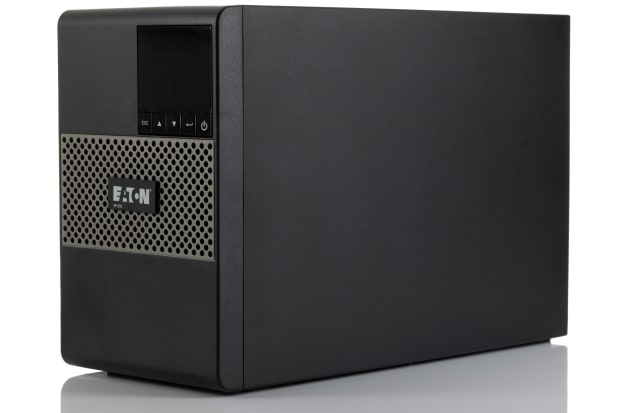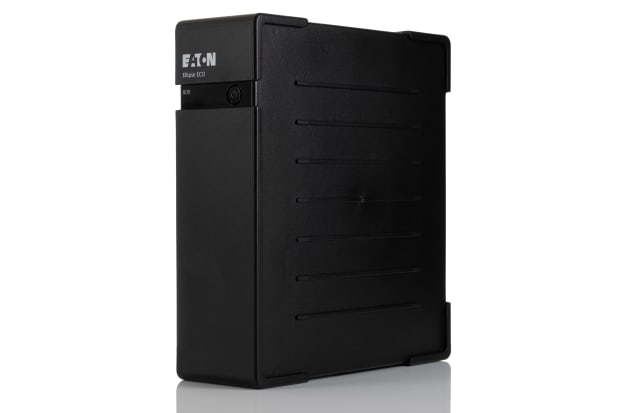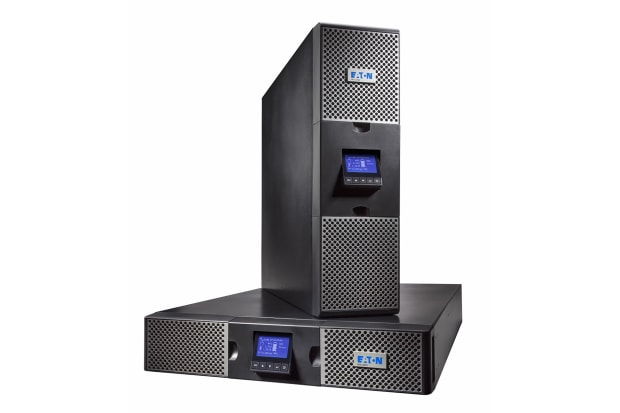- Published May 15, 2024
- Last Modified May 15, 2024
- 9 min
A Complete Guide to Uninterruptible Power Supplies (UPS) by Eaton
Uninterruptible Power Supplies provide valuable fail-safe memory protection for computers and hardware. Read on to find out everything you need to know about UPS devices with this helpful guide from RS and Eaton.

Uninterruptible Power Supplies Explained
When there’s problems with your power supply, the last thing you need is damage to your computers and memory-based tech hardware adding to your frustration. At RS, we know that Uninterruptible Power Supplies are a vital backup solution. That’s why we’ve partnered with the power management experts at Eaton to help you choose a UPS that'll keep your data and hardware safe at the most critical times.
What is an Uninterruptible Power Supply?

The core purpose of a UPS is to function as a constant secondary power source - effectively an on-demand, instant-switch battery backup - for computers, servers, data centres, and anywhere else you need to store information. A sudden loss of power can cause damage to the delicate hardware components in your PCs, so a quality UPS system is designed to protect them (and the data they rely on) in the event of a blackout, mains surge, or other unexpected power events.
Who uses UPS units?
These devices are becoming increasingly popular as add-on peripherals for home and work PC setups, server and network environments, and many other hardware-critical computing applications. In these sorts of scenarios, uninterruptible power supplies can offer you additional peace of mind and an extra level of safety for both your hardware and your data.
To help you decide which UPS is right for you, this guide will explain:
- What does a UPS do?
- How do they protect equipment?
- What different types of UPS are available in today’s market?
A quick note on naming conventions…
In the context of tech hardware, the acronym UPS stands for uninterruptible power supply, and so technically the phrase ‘UPS power supply’ is a handy example of RAS syndrome (along with ‘PIN number’ and ‘LCD display’)! However, it remains a very commonly used term among customers and suppliers alike, and so for this guide, we’ll use both the standalone acronym and the longer version interchangeably.
How does a UPS work?

As we noted earlier, a UPS works as an uninterruptible backup power source for your computer setups and other important hardware arrays in the event of electrical disruption. These units are designed to provide a limited window of time in which you can perform a controlled shutdown of the device when mains power is no longer available.
How does a UPS do this? Essentially by collecting and storing some of the power being drawn from the wall socket in its internal battery, with the remaining power being sent onto the computer as normal. When power flow suddenly stops for any reason, such as a power cut, the UPS instantly switches to sending out the stored backup power.
Keep in mind…
A UPS isn't designed to provide long-term backup use of connected devices for extended periods without power, or offer a battery-operated solution for continuing to work off-grid.
What’s a UPS made up of?
A typical home or office UPS battery backup usually consists of a high-drain rechargeable power cell encased inside a small ‘smart’ unit. You’ll find these power supply units placed between the mains wall socket and the PC being powered, plugged into each by separate cables. Traditionally the battery will most often be a lead-acid (VRLA) type, but ongoing advancements in lithium-ion technology mean that Li-ion cells are now becoming increasingly used as well.
UPS battery types
VRLA (Valve-Regulated Lead Acid)
- Low-maintenance – a basic and reliable UPS lead-acid battery with a typical 5-year lifespan
- ‘Valve-regulated’ simply means that this type uses built-in automatically operated vent systems, which are triggered by internal pressure sensors. This is to control the release of pressure from any gradual gas build-up that may occur in extreme conditions
- Performs best in dry-temperature controlled environments, such as a centrally-heated room in a home or office
Li-ion (Lithium Ion)
- Compact and lightweight, often has multiple built-in power management features such as charge and voltage balancing
- Higher cost upfront however they have a longer lifespan than other batteries, making them comparably economical over a long timeline
VLA (‘Wet/Flooded Cell’)
- Intended for specific applications and environments and are not widely available
- Potentially hazardous due to their chemical composition (unless kept in a separate battery storage saferoom), and require regular user maintenance and monitoring, but offer a high level of reliability and stability
- More suited for specific use cases such as large-scale server centres
Say goodbye to data loss and hardware damage…

UPS units are critical for protecting vulnerable (and often expensive) hardware components from physical or memory-based damage when they’re suddenly disconnected from the main power circuit. Even in the case of a total power-off event mid-transfer, a UPS can ensure vital data isn’t lost.
Why is this a big deal? Well, interruption of core processes can cause serious irreparable physical damage, as well as massive data loss/error, which is why there is usually an approved disconnect process for almost any type of data transfer activity. In the worst-case scenarios, files can become unreadable by devices at both ends of the transfer if it’s interrupted. Corrupted data can sometimes still be salvaged by a specialised recovery technician (often at a large cost!) but if they’re unable to repair or retrieve it then your data can be lost forever.
You may already have some of your important data backed up, but a UPS will help you to also protect the more integral background transfer processes that are constantly happening at both hardware and operating system levels any time a computer is powered on and running – many of which are key to the machine’s ability to function.
Types of Uninterruptible Power Supplies
Choosing the right UPS power supply to best suit your hardware setup and operating requirements comes down to a few key variants. Read all about the different types and their features below:
Offline/Standby UPS
- This type ‘idles’ until needed. When the offline/standby UPS detects that power conditions are registering as normal it effectively allows itself to be bypassed. The instant it detects a problem – usually within 5 milliseconds for most quality models and brands – the offline power supply switches over to its internal battery backup instead.
- This very slight ‘interruption’ is why they aren’t considered ‘true UPS’ devices by professional users, however, they tend to be a perfectly functional (and much more cost-effective) stand-in for most domestic desktop PC owners. They are only really seen as unsuitable in very critical applications where any risk of data or hardware loss is unacceptable.
Line-Interactive UPS
- As the name suggests, the hybrid versions (which usually include the so-called ‘line-interactive’ UPS units) offer a middle ground between the online and offline types.
- They offer various operating modes such as double conversion mode, economy mode, and active filter mode - and the hybrid UPS can detect which is most appropriate at any given moment. They can do this through the use of a power transformer system, which ensures a lower total power draw over a typical period of operation than an online version.
- The line-interactive UPS is significantly more effective at monitoring, managing, and adjusting to flow variations during ‘brownouts’, which involve fluctuations in current rather than the total loss of power involved in a blackout and are far more common.
- Hybrid models offer greatly increased long-term health of the battery as it does not have to continually switch between supplying wholly mains or battery power.
Online Double Conversion UPS
- Often called a ‘true UPS’, this type of unit constantly filters, stores, and delivers electrical flow to your PC, even when conditions are normal. The term ‘online’ derives from this and not internet connectivity, as you might assume.
- Due to this, there is zero interruption when power loss occurs and the supply of clean, stable power to your intended PC continues seamlessly. An online UPS, therefore, is always performing the task it is designed to perform.
- Typically the most costly type of power supply and provides the greatest security against unexpected current fluctuation or sudden power loss, making them a top-end option for most usage scenarios. The power draw and running costs are considerably higher, however, this type is ideal for certain critical roles and environments where any performance or data loss would be catastrophic.
Difference between single-phase, three-phase, and split-phase
A phase refers to the number of electrical phases that a UPS receives and transmits. Three-phase power is the most efficient way of transporting electricity over long distances so for larger power consumers a three-phase UPS is required. For smaller power consumers such as office buildings and schools, power is converted to single-phase. A split-phase UPS can simultaneously provide 120V and 208V output for applications which use a mix of single-phase and three-phase equipment, protecting both.
What to consider when buying a UPS?

The types of circuit protection you need, such as:
- Blackout
- Brownout
- Surge
- Over-voltage
- Under-voltage
- Deep discharge
- Harmonic distortion
- Frequency variation
The amount of UPS power you need i.e. the capacity, which will involve working out:
- How many devices you’re going to plug into it
- The combined power draw of those devices, in wattage
How long you need to be able to run those devices in the event of a blackout:
The UPS runtime depends entirely on the size of the battery and how many devices it is being asked to support. This is calculated by capacity and load. You’ll need, as a bare minimum, to know the amount of time needed to access your computer(s) and shut down properly
Other factors to consider:
- Appearance
- Physical size and form
- Positioning in the office/home for best access and safety
Eaton 9PX UPS

If you need a UPS that delivers steadfast power protection whilst saving on energy costs, Eaton’s 9PX UPS is the ideal choice. These units offer double conversion protection with 40% less energy usage, constantly monitoring your power conditions and regulating voltage and frequency. They come in a conveniently compact and versatile rack/tower form factor and are perfectly suited for use in small and medium datacentres, IT rooms, and Infrastructure.
Features of the 9PX UPS:
- Up to 95% efficiency in online double conversion mode and 98% in high-efficiency mode – the highest level in its class – for minimal energy and cooling costs
- The LCD (Liquid-Crystal Display) gives you clear information on the device’s status and measurements via a single screen
- 0.9 power factor means that the 9PX delivers 28% more power than any UPS in its class
- Uses Eaton’s exclusive ABM battery management technology to extend battery life by up to 50% for a stronger and longer battery life
- Can accurately meter your energy consumption, for cost-efficient power management
- Includes serial, USB and relay connectivity, as well as an extra slot for an optional card
Related links
- Uninterruptible Power Supplies
- APC 160 → 286V Input Stand Alone Uninterruptible Power Supply Smart-UPS SMT
- Phoenix Contact 12V Input Uninterruptible Power Supply, UPS-BAT-KIT
- Phoenix Contact 29.5V dc Input DIN Rail Uninterruptible Power...
- APC 160 → 286V Input Rack Mount Uninterruptible Power Supply Smart-UPS SMT
- APC 160 → 286V Input Rack Mount Uninterruptible Power Supply Smart-UPS SMT
- APC 160 → 286V Input Stand Alone Uninterruptible Power Supply Smart-UPS SMT
- APC 160 → 286V Input Rack Mount Uninterruptible Power Supply Smart-UPS SMT